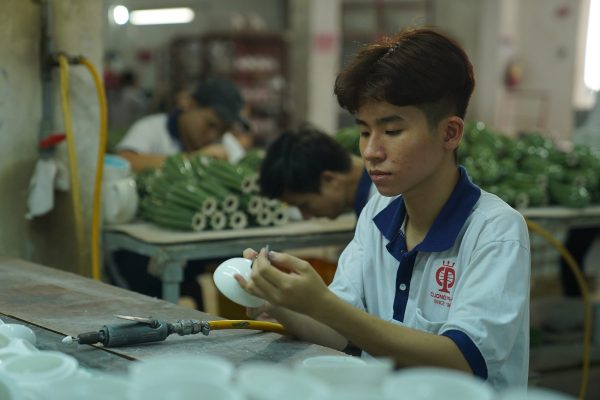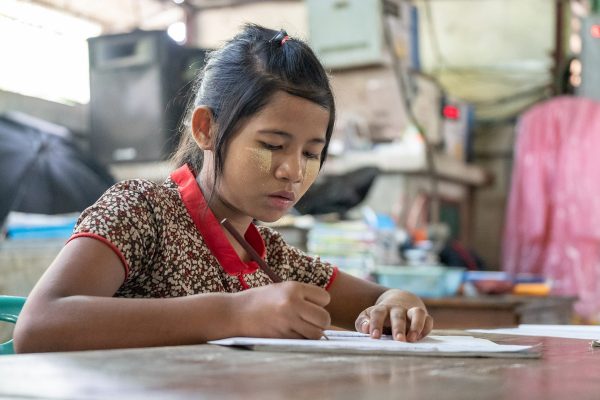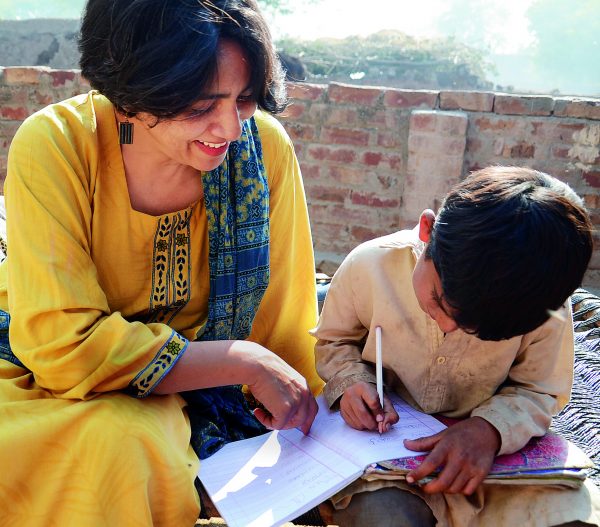Child Labour
As part of the UN Sustainable Development Goals, the international community adopted the ambitious goal of ending child labour by 2025. But millions of children around the world are still trapped in child labour, depriving them of their childhood, health and education, and condemning them to a life of poverty.
Recent global estimates indicate that a total of 168 million children aged 5 to 17 are engaged in child labour (down by some 30% from 246 million in 2000). These figures indicate a steady decline in child labour, but progress is far too slow.
Despite the fact that businesses are more aware of and increasingly proficient in developing responses to child labour risks, Global Child Forum’s benchmark report findings raise concerns around the actual impact of the policies in place and their implementation throughout operations and supply chains.
Take the next step
Read about 10 sustainable business approaches to addressing child labour, in our guide.
 Reframing Child Labour Due Diligence
Reframing Child Labour Due Diligence
How can ESG data and analyst requirements be re-framed to identify sustainable actions for eliminating child labour in supply chains?
 Child Labour in the 21st Century: An Urgent Call for Action & Reform
Child Labour in the 21st Century: An Urgent Call for Action & Reform
As we mark World Day Against Child Labour, Global Child Forum urges nations to adopt policies tackling root causes and protecting children.
 Ending Child Labour: A Call for Business Action and Accountability
Ending Child Labour: A Call for Business Action and Accountability
The call to end child labour has taken on increased urgency. What can businesses do to return child labourers to the classroom?
 Due diligence and beyond: How Nestlé manages human rights risks in the supply chain
Due diligence and beyond: How Nestlé manages human rights risks in the supply chain
For Nestlé, a global company that sources products from the agricultural sector, addressing human rights risks in the supply chain is both a basic requirement and not always an easy task.
 Bayer: Mitigating root causes of child labour
Bayer: Mitigating root causes of child labour
Learn about Bayer’s advancements in the area of child labour mitigation, through the implementation of its Child Care Programme (CCP).
 Global Benchmark Report - The State of Children’s Rights and Business 2021
Global Benchmark Report - The State of Children’s Rights and Business 2021
Are companies prioritizing children’s rights among all the other issues on the sustainability agenda? Learn more from our Global Benchmark - The State of Children's Rights and Business 2021
 What does it take to be a corporate leader on children's rights?
What does it take to be a corporate leader on children's rights?
Johan Öberg of Boston Consulting Group shares his insights on what it takes to be a corporate leader on children’s rights.
 Wilmar’s Path Towards Responsible Sustainability Management
Wilmar’s Path Towards Responsible Sustainability Management
A study showcasing Wilmar’s path towards a more sustainable business, and how to integrate a child rights perspective.
 The State of Children's Rights and Business in Southeast Asia 2020
The State of Children's Rights and Business in Southeast Asia 2020
The State of Children's Rights and Business in Southeast Asia 2020
 A Watershed Moment for Business: The effects of COVID-19 young people
A Watershed Moment for Business: The effects of COVID-19 young people
Of all the heartbreaking effects of COVID-19, its impact on young people could prove to be one of its most damaging legacies. In fact, the coronavirus crisis risks turning back the clock on years of progress made on children’s well-being and has put children’s rights under serious pressure across the globe. Linda Lodding, Head of Communications at Global Child Forum, takes a closer look at these pressure points.
 COVID-19 and Child Labor
COVID-19 and Child Labor
As is the case in most crises, the most vulnerable in society will feel the worst impacts of COVID-19.
 Listening and learning: Top 10 children’s rights issues for business to consider
Listening and learning: Top 10 children’s rights issues for business to consider
To mark Global Child Forum’s ten-year anniversary, Désirée Abrahams asked both adults and children, what they considered the top 10 most important child right’s issues for business to consider in the next decade. In this blog post, she shares her reflections on the process and the survey’s findings
 Child Labour Policy: An integrated approach
Child Labour Policy: An integrated approach
The world has taken on the task to eliminate child labour. What are we doing wrong, and how can we finally make it a thing of the past?
 Child Labour Policy Guide
Child Labour Policy Guide
Global Child Forum’s Child Labour Policy Guide presents a series of sustainable business approaches developed to combat child labour.
 Child Labour in Myanmar: Two Girls get a New Start and Skills through Remediation
Child Labour in Myanmar: Two Girls get a New Start and Skills through Remediation
CCR CSR, The Center for Child Rights and Corporate Social Responsibility, supports two girls from Myanmar getting back to school.
 Children’s Voices - Vietnam story
Children’s Voices - Vietnam story
Take a look at the story of Tran Thanh Nam, a former bartender and current employee at Cuong Phat Pottery Company in Binh Duong, Vietnam.
 Children’s Voices - Myanmar story
Children’s Voices - Myanmar story
Take a look at the story of Warwar Nwe, who was just ten years-old when she had to drop out of school.
 Time to Listen: Incorporating children's voices in business decisions
Time to Listen: Incorporating children's voices in business decisions
At the 10th Global Child Forum, Fauza and Kesia, two youth workers and members of the Indonesian Children's Advisory Committee shared their message to business on behalf of the world's working children.
 Norsk Hydro Brazil’s journey towards social responsibility
Norsk Hydro Brazil’s journey towards social responsibility
This case study on Norsk Hydro Brazil and social responsibility shows how the company addresses children’s rights and related issues in its operations.
 ISS: Managing risk as a business model
ISS: Managing risk as a business model
Our case study on ISS and managing risk explores the policies the corporate group has put in place to safeguard children’s rights.
 Clothing brands play an important role in tackling child labour
Clothing brands play an important role in tackling child labour
Clothing brands can learn from their peers who dare to be honest about detecting child labour in their supply chains by knowing the risks, limiting them, and taking action where necessary. As fashion designers take to the runway during New York Fashion Week, Sophie Koers, Associate Director of Fair Wear Foundation, reminds us that all that glitters is not necessarily gold.
 Millicom: Making the internet safe again
Millicom: Making the internet safe again
This case study details how international telecommunications and media company Millicom strives to make the internet safer for children.
 CELESC: A multi-faceted approach to children’s rights
CELESC: A multi-faceted approach to children’s rights
CELESC is eliminating child labour in its supply chain through policies, contractual clauses, and other initiatives.
 Grupo Telecom: Protecting children online is all about education
Grupo Telecom: Protecting children online is all about education
This study on Grupo Telecom is part of our series looking at how companies find solutions to support children’s rights.
Save the Children has been working together with Samsung Electronics China to set up ambitious policies on child labour prevention and training all managers in China on children’s rights and how to practically approach issues specifically relating to young workers. Frank Du is vice president and in charge of Human Resources at Samsung Electronics in China. Children’s rights and business videos
Clas Ohlson is a leading hardware retailer in Sweden with over 200 stores in five countries. They source almost 70% of their products from Asia. Save the Children has supported Clas Ohlson with a child rights focused assessment of their entire value chain and continues to offer on-site support to factories in China. Klas Balkow is the CEO of Clas Ohlson. Children’s rights and business videos
International furniture giant IKEA has been at the forefront of corporate work on human rights and sustainability for decades. Since the early 1990s, IKEA has been working with Save the Children on a range of projects addressing education for children, children in emergencies, and protection of children from child labour. Steve Howard is the Chief Sustainability Officer at IKEA Group. Children’s rights and business videos
 Toolkit Juara Child-Friendly Business: A guidance for business (hotel and restaurant) integrating children’s rights
Toolkit Juara Child-Friendly Business: A guidance for business (hotel and restaurant) integrating children’s rights
Together with the Indonesian Hotel and Restaurant Association (PHRI) in West Java, Save the Children has been integrating a child-centred corporate social responsibility project in the hospitality sector of Indonesia. The project worked to encourage members to integrate children’s rights into their member’s business operations and strategies. One result of the project was the creation of this toolkit, which included the assistance of academics, several NGOs, and input from child and youth participants. It consists of four tools for children’s rights integration and eight tools that inspire hotels and restaurants in responding to issues and problems that most frequently arise and impact children’s rights.
Children’s rights are an essential investment in a sustainable future. Safeguarding these rights helps build the strong, well-educated communities that are vital to creating stable, inclusive and productive societies. The private sector impacts children’s lives both directly and indirectly, and all companies in all industries – global, regional or local – can make a difference. Business activity influences the daily life of children in a number of ways, from impoverished communities where children are held back from getting an education because they need to support the family with their income, to the marketplace where children react to marketing messages and learn about the world via the many products surrounding them. Companies that want to take part in the movement pushing sustainable development forward, creating the world that we together have formulated in the Sustainable Development Goals and Agenda 2030, need to safeguard, empower and consider the opinions of those we should be creating that world together with. Considering children’s rights holds the possibility of enriching your business and easing your way into the challenges of the future. Read these statements from companies and businesses that have incorporated a child rights approach into their work.
 Thai Union: Supporting Children Through Education
Thai Union: Supporting Children Through Education
This case study examines how seafood company, Thai Union, supports children through increased access to education.
 IKEA’s broadening perspective on the best interest of the child
IKEA’s broadening perspective on the best interest of the child
How did IKEA go from not mentioning child rights to making children central stakeholders of their company? Read our report to find out more.
 Stora Enso: Mitigating Child Labour
Stora Enso: Mitigating Child Labour
A study investigating how Stora Enso found itself in crisis over child labour in its supply chain, and took action to remedy the situation.
This Guide is written for civil society organizations that use or wish to use the Children’s Rights and Business Principles to engage with businesses in monitoring, enforcing and advancing children’s rights. To give a broad perspective on the ways that civil society might seek to work with companies, organizations’ diverse missions, goals and methods of working are taken into account. As a result, this Guide can be used by a wide range of civil society actors in considering, developing and reviewing their approaches to and relationships with business entities. Advocacy is a central focus, with the primary goal being to hold businesses accountable for their impacts on children’s rights. The Guide is divided into Five Parts Part I introduces the Guide and establishes the international relevance of the Children’s Rights and Business Principles. Part II explains the corporate duty to respect and commitment to support children’s rights in theory and in practice. Part III explores each of the nine substantive Children’s Rights & Business Principles in detail. Part IV addresses ways that additional stakeholders including government, the media, consumers and children can enhance cooperation between business and civil society in matters of children’s rights. Part V offers conclusions and a selection of resources for further research.
This publication presents UNICEF’s stance and approach to child labour. While upholding the Convention on the Rights of the Child, UNICEF and its partners work to strengthen legal and policy frameworks, enhance government and community-based structures and services, and engage with communities to promote positive social change. To achieve positive results, promoting understanding through research of the underlying causes of child labour and addressing their interconnectedness is key to UNICEF’s approach to response and prevention.
 Children’s Rights in Impact Assessments: A guide for integrating children’s rights into impact assessments and taking action for children
Children’s Rights in Impact Assessments: A guide for integrating children’s rights into impact assessments and taking action for children
This publication is designed to guide companies in assessing their policies and processes to both prevent harm and actively safeguard children’s best interests. As a tool, this should be used as part of ongoing assessments of human rights impacts as outlined in the United Nations Guiding Principles on Business and Human Rights. This publication has 58 primary criteria for addressing company policies and practices relevant to children’s rights. A company is taking an important step towards recognizing children as rights holders and stake holders by integrating children’s rights considerations into their ongoing impact assessments.







